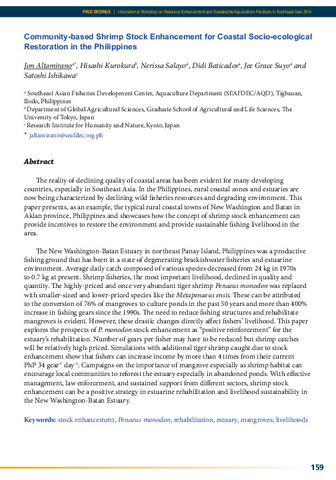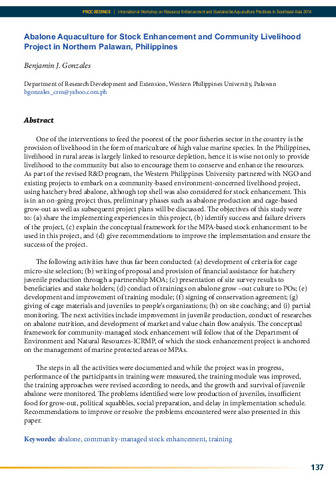Perlihatkan publikasi sederhana
Evaluation of community-based livelihood development initiatives: The sustainable livelihood approach
| dc.contributor.author | Salayo, Nerissa D. | |
| dc.contributor.author | Castel, Raisa Joy G. | |
| dc.contributor.author | Montinola, Quenie S. | |
| dc.contributor.author | Diamante, Rose Ann | |
| dc.contributor.author | Kodama, Masashi | |
| dc.contributor.editor | Ferrer, Alice Joan | |
| dc.coverage.spatial | Guimaras | en |
| dc.date.accessioned | 2023-03-10T08:29:16Z | |
| dc.date.available | 2023-03-10T08:29:16Z | |
| dc.date.issued | 2022 | |
| dc.identifier.citation | Salayo, N. D., Castel, R. J. G., Montinola, Q. S., Diamante, R. A., & Kodama, M. (2022). Evaluation of community-based livelihood development initiatives: The sustainable livelihood approach. In A. J. G. Ferrer (Ed.), Proceeding of Joint International Conference of the Sixth International Conference on Fisheries and Aquatic Sciences (ICFAS 6) and Asian Fisheries Social Science Research Network Forum One (AFSSRN F1), 24-26 November 2021, via Zoom, Miagao, Iloilo, Philippines (pp. 473–480). University of the Philippines Visayas. | en |
| dc.identifier.isbn | 9786218285125 | |
| dc.identifier.uri | http://hdl.handle.net/10862/6420 | |
| dc.description.abstract | The sustainable livelihood approach (SLA) is a tool for evaluating livelihood strategies that utilize assets categorized as environmental, human, physical, financial and social assets. In this study, the SLA was applied to determine the main factors that influence the adoption of integrated multi-trophic aquaculture (IMTA) in milkfish (Chanos chanos Forsskål) farming among fisherfolks. The community-based field trials conducted in Nueva Valencia in Guimaras province for 4 years since 2015 revealed that stakeholders were receptive to IMTA and were able to situate its effects on livelihood assets. The assessment of 52 stakeholders showed small but significant improvements in most livelihood assets during the 3-phased evaluation period. Using the 5-scale Likert rating, the environmental livelihood assets were rated highest but showed slight significant decline due to perceived weather and water level changes that may have negatively affected fish production and income. Financial livelihood assets were initially rated low but significantly improved due to supplemental income derived from wages and harvest. The human livelihood assets significantly improved due to sustained hands-on aquaculture experience. Social livelihood assets also improved due to cohesive interaction during projects implementation. In contrast, the acquisition of physical livelihood assets did not significantly improve because these assets were not commensurate with the many stakeholders who would like to have access to these shared assets. Overall, stakeholders expect IMTA’s potential environmental and economic benefits to overcome additional adoption costs. These include the cost of physical and financial investments in seeds of co-culture species and modified enclosures. Stakeholders expect institutional and government support on further studies on the technical details of IMTA. Fisheries and aquaculture regulations should embed the necessary support systems for the adoption of IMTA and ensure a positive public perception of aquaculture. | en |
| dc.language.iso | en | en |
| dc.publisher | University of the Philippines Visayas | en |
| dc.subject | milkfish | en |
| dc.subject | Chanos chanos | en |
| dc.title | Evaluation of community-based livelihood development initiatives: The sustainable livelihood approach | en |
| dc.type | Conference paper | en |
| dc.citation.spage | 473 | en |
| dc.citation.epage | 480 | en |
| dc.citation.conferenceTitle | Proceeding of Joint International Conference of the Sixth International Conference on Fisheries and Aquatic Sciences (ICFAS 6) and Asian Fisheries Social Science Research Network Forum One (AFSSRN F1), 24-26 November 2021, via Zoom, Miagao, Iloilo, Philippines | en |
| dc.subject.asfa | milkfish culture | en |
| dc.subject.asfa | livelihoods | en |
| dc.subject.asfa | aquaculture | en |
| dc.subject.asfa | community involvement | en |
| dc.subject.scientificName | Chanos chanos | en |
| local.subject | milkfish culture | en |
| local.subject | livelihood development | en |
| local.subject | community-based projects | en |
Files in this item
| Files | Size | Format | View |
|---|---|---|---|
|
There are no files associated with this item. |
|||
Publikasi ini ada di koleksi berikut
-
Conference Proceedings [298]



